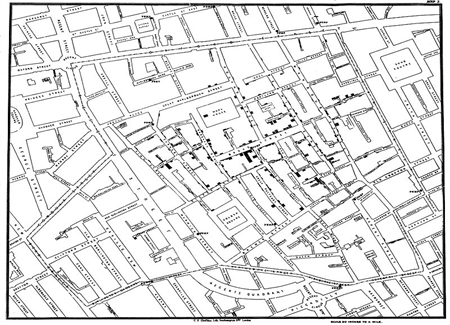Web Exclusive
Did a Cholera Outbreak Inspire ICD-1?
By Jon Elion, MD, FACC
I wasn't the first and I won't be the last to take a shot at summarizing some of the history of the first international classification of diseases, a process that started in 1853 and was finally approved in 1893. While this was not officially called "ICD-1," it was in fact the first international standard for disease and mortality classification.
But what was going on in 1853 that might have motivated the first International Statistical Congress to pass a resolution requesting the preparation of a uniform classification of the causes of death? That was the year that the third cholera pandemic was breaking out, starting in Russia and spreading to Indonesia, China, Japan, the Philippines, Spain, England, and the United States. At that time, the predominant theory about the spread of disease was that it was caused by "bad air."
But physicians in London had already started to seek a more formalized approach to the spread of diseases, following an earlier cholera outbreak in 1831. They formed the Epidemiological Society of London in 1850 "to institute rigid examination into the causes and conditions which influence the origin, propagation, mitigation, and prevention of epidemic diseases."
A major cholera outbreak struck the Soho neighborhood of London in the summer of 1854, resulting in the death of more than 500 people, all within 250 yards of the intersection of Cambridge Street and Broad Street. This caught the attention of London physician John Snow, one of the founding members of the Epidemiological Society. He was skeptical of the "bad air" theory, and used a dot map to show the cluster of cases around the public water pump on Broad Street:

The official story is that his evidence convinced the local council to disable the well pump by removing its handle. A more colorful version of the tale has Snow secretly removing the pump handle at night, after the local council delayed taking action. That version is reportedly part of the inspiration behind the final words of "Subterranean Homesick Blues" by Bob Dylan: "The pump don't work 'cause the vandals took the handles."
Snow was clearly a man ahead of his times. The "germ theory" of disease did not yet exist. It wasn't until 1885 that Robert Koch identified the Vibrio cholerae bacillus as the cause of the disease. In fact, the field of epidemiology did not even exist yet, despite the title of the London medical society.
Tracking the cholera pandemics created a worldwide interest in disease patterns and spread and helped to create the need for a way to classify disease. We'll never know for sure if that was the driving inspiration behind the first international disease classification. But that's my story, and I'm sticking to it.
— Jon Elion, MD, FACC, is founder/president of ChartWise Medical Systems; a practicing board-certified cardiologist in Providence, Rhode Island; and an associate professor of medicine at Brown University.



